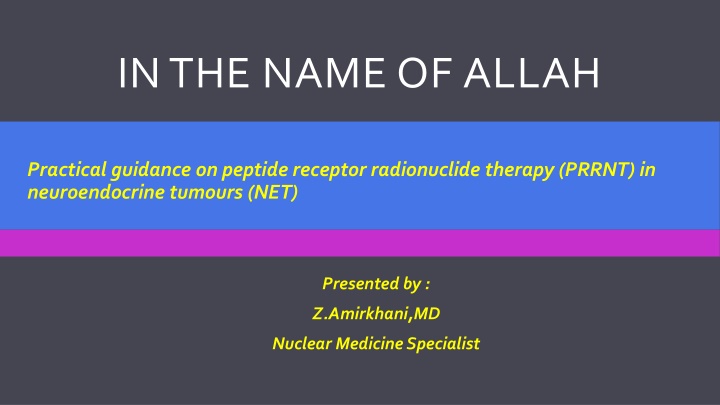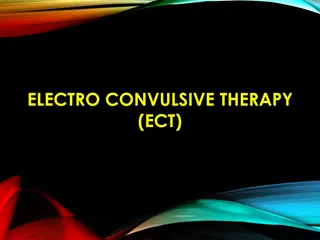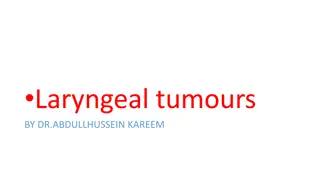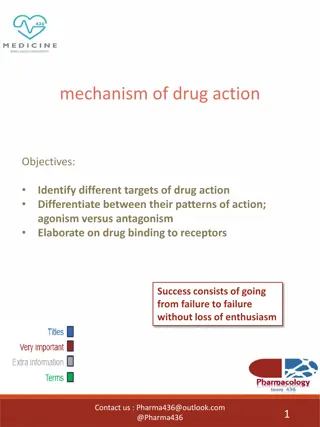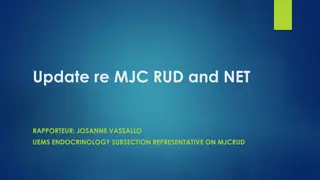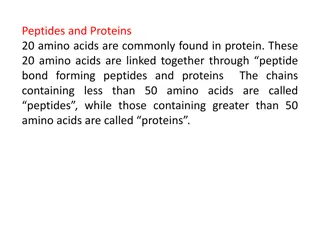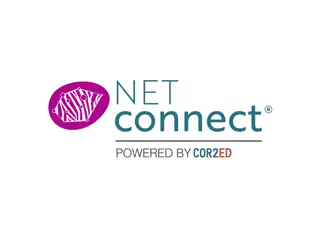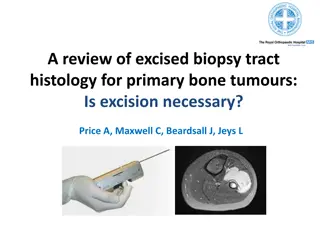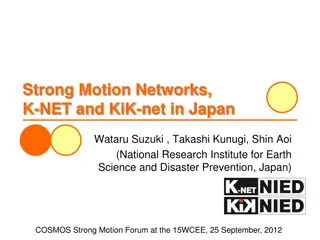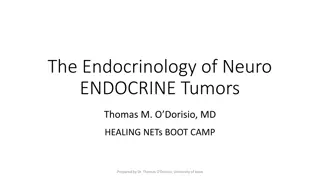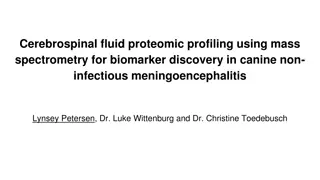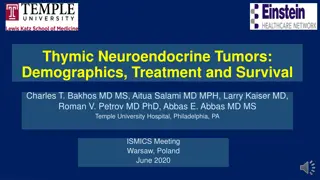Comprehensive Guide to Peptide Receptor Radionuclide Therapy (PRRNT) in Neuroendocrine Tumours (NET)
Peptide Receptor Radionuclide Therapy (PRRNT) is a targeted approach using radiopharmaceuticals to deliver radiation to neuroendocrine tumors expressing specific receptors. This therapy, involving 90Y-DOTATOC or 177Lu-DOTATATE, has shown promising results in treating NETs with minimal side effects. Understanding patient eligibility, treatment protocols, and potential outcomes is crucial for safe and effective implementation of PRRNT, especially in slow-growing neuroendocrine malignancies overexpressing somatostatin receptors.
Download Presentation

Please find below an Image/Link to download the presentation.
The content on the website is provided AS IS for your information and personal use only. It may not be sold, licensed, or shared on other websites without obtaining consent from the author.If you encounter any issues during the download, it is possible that the publisher has removed the file from their server.
You are allowed to download the files provided on this website for personal or commercial use, subject to the condition that they are used lawfully. All files are the property of their respective owners.
The content on the website is provided AS IS for your information and personal use only. It may not be sold, licensed, or shared on other websites without obtaining consent from the author.
E N D
Presentation Transcript
IN THE NAME OF ALLAH Practical guidance on peptide receptor radionuclide therapy (PRRNT) in neuroendocrine tumours (NET) Presented by : Z.Amirkhani,MD Nuclear Medicine Specialist
PURPOSE: 1. Assessing patients with neuroendocrine tumors (NETs) for their eligibility to undergo treatment with 90Y-or 177Lu-radiolabelled somatostatin analogues. 2. Providing guidance on performing peptide receptor radionuclide therapy (PRRNT) and implementing this treatment in a safe and effective manner. 3. Understanding and evaluating the outcome of PRRNT, namely treatment results and possible side effects including both renal and hematological toxicities.
BACKGROUND INFORMATION AND DEFINITIONS: PRRNT PRRNT (or PRRT) involves the systemic administration of a specific well-defined radiopharmaceutical composed of a -emitting radionuclide chelated to a peptide for the purpose of delivering cytotoxic radiation to a tumor. commonly cell surface receptors, such as the somatostatin receptor (sstr) subtype 2 (sstr2) that is overexpressed on the cell surface of NETs in a tumor-specific fashion, thereby ensuring a high level of specificity in the delivery of the radiation to the tumor.
PRRNT is a molecularly targeted radiation therapy, and thus is distinct from external beam radiation therapy. PRRNT employing the radiotagged somatostatin receptor agonists: - 90Y-DOTATOC([90Y-DOTA0,Tyr3]-octreotide) or - 177Lu-DOTATATE ([177Lu-DOTA0,Tyr3,Thr8]-octreotide or [177Lu-DOTA0,Tyr3]-octreotate) to target metastatic or inoperable neuroendocrine tumors expressing the somatostatin receptor subtype 2. which leads to partial or complete objective responses in up to 30 % of treated patients.
Yttrium-90 - The radiometal90Y is a pure -emitting isotope with a physical half-life of 64 h. - The maximum and mean -particle energies are 2.28 MeV and 0.934 MeV, respectively. - The maximum and mean -particle penetration depths in soft tissue are 11 mm and 3.9 mm, respectively. Lutetium-177 - 177Lu is a -and -emitting radionuclide with a physical half-life of 162 h (6.73 days). - Compared to 90Y, 177Lu has lower maximum and mean -particle energies (0.498 MeVand0.133 MeV, respectively). - These translate to maximum and mean soft-tissue penetration depths of 1.7 mm and 0.23 mm, respectively. - 177Lu has two main gamma emission lines: 113 keV (6 % relative abundance) and 208 keV(11 % relative abundance). - The latter properties of 177Lu allow posttreatmentimaging and dosimetry assessments.
NETS - Ideal neoplasms for PRRNT, as the majority of these slow-growing malignancies overexpress sstrs. - Appropriate candidates for PRRNT are patients presenting with well-differentiatedor moderatelydifferentiatedneuroendocrine carcinomas, defined as NETs of grade 1 or 2. - NETs can occur in children and young adults, being diagnosed as early as at the age of 5 years, while their incidence increases with age. - 72 % of NETs arise in gastrointestinal structures, 25 % are Broncho pulmonary in origin, and less than 5 % arise at other sites (e.g. thymus, breast and genitourinary system).
- Functioning tumors are associated with clinical syndromes, such as the carcinoid syndrome (due to the release of serotonin). Other secreting tumoursinclude insulinomas (inducing hypoglycaemia), gastrinomas (inducing Zollinger-Ellison syndrome), VIPomas (associated with the watery diarrhoea, hypokalaemia and achlorhydriasyndrome; WDHA syndrome). -Functional imaging procedures applying sstr imaging using 111In-pentetreotide (OctreoScan) with SPECT or PET with 68Ga-labelled SSA, combined with morpho- logical imaging procedures, are used to collect essential information for staging, assessing sstr status and making decisions on the most appropriate therapy regimens.
TREATMENT OPTIONS IN NETS Multiple treatment approaches are now available for patients presenting with metastatic disease. For the choice of the most appropriate treatment, information regarding anatomical location and local invasion of adjacent structures, tumour functionality, sstr status, histological grading and staging are required to facilitate the decision-making process within the multidisciplinary tumour board. Therapeutic options include surgery, interferon, chemotherapy, molecularly targeted agents, locoregional therapies and PRRNT and ..
Systemic chemotherapy is effective in some patients, especially those with poorly differentiated NET/neuroendocrine carcinoma. PRRNT is very rarely a suitable treatment option for neuroendocrine carcinoma (grade 3), because of the low expression of sstrbut it may be considered following the failure of chemotherapy and if 111In-pentetreotide (OctreoScan) or 68Ga- DOTATOC/DOTATATE PET/CT demonstrates moderate to high sstrexpression. Effective treatment of NETs, such as PRRNT, may alleviate pain, including bone pain. Treatment of painful bone metastasis is also mandatory with the administration of bisphosphonates as supportive therapy.
INDICATIONS AND CONTRAINDICATIONS Indications PRRNT is indicated for the treatment of patients with positive expression of sstr2, or metastatic or inoperable NET. Candidate patients for PRRNT using radiolabelled somatostatin analogues are mainly those with sstr2-expressing NET of the gastroenteropancreatic and bronchial tracts, but may also include patients with phaeochromocytoma, paraganglioma, neuroblastomaor medullary thyroid carcinoma . Less favourableresults have been reported for thymic NETs, dedifferentiated thyroid carcinomas, sstr-positive tumoursincluding meningiomas, medulloblastomas and astrocytomas
Contraindications oAbsolute For 177Lu-labelled peptide a mild to moderate grade of renal impairment can be tolerated (e.g. creatinine 1.7mg/dl). Glomerular filtration rate (GFR) and tubular extraction rate (TER) should be at least 60 % of mean age-adjusted normal values. 1. Pregnancy 2. Severe acute concomitant illnesses. 3. Severely compromised bone marrow: noncom promised hematological reserve should be present before PRRNT. 3. oRelative Severe unmanageable psychiatric disorder. Suggested reference values are: WBC<3,000/ with absolute neutrophil count <1,000/ l PLT <75,000/ l for 177Lu-DOTATATE, <90,000/ l for 90Y-DOTATOC, RBC <3,000,000/ l. 1. Breast feeding (if not discontinued). 2. Severely compromised renal function: Patients with compromised renal function may still be considered for 177Lu-labelled peptide treatment.
SPECIAL WARNINGS Renal function The kidney is the dose-limiting organ at the activities normally used for PRRNT. Side effects involving the kidney and the bone marrow are mild if adequate renal protection and fractionation are used. Renal function should be assessed by means of laboratory tests (creatinine and BUN), or calculation of creatinine clearance (e.g. Cockroft-Gault formula). Additional studies, e.g. measurement of GFR with 24-h urine collection or nuclear medicine methods (e.g. 99mTc-MAG3 with TER determination, 99mTc-DTPA GFR or effective renal plasma flow using hippuran), should be performed in patients with risk factors for renal toxicity or with compromised renal function, and in all children.
Aggravating conditions (caveats) - Renal outflow obstruction, potentially leading to hydronephrosis, and, ultimately, to loss of renal function, should always be ruled out or otherwise corrected before PRRNT. - Previous myelotoxic chemotherapy and extended external beam irradiation fields to the bone marrow (pelvis, spine), particularly if performed in the weeks preceding the PRRNT, do increase the risk of bone marrow failure after PRRNT. - In doubtful cases of hematological compromise, a bone marrow biopsy might be indicated to assess bone marrow status in pretreated patients and to assess the risk when planning for multiple PRRNT cycles (e.g. intervals between cycles).
PROCEDURE 1. Pretherapy assessment - NET proven by histopathology (immunohistochemistry). - High sstr expression determined by functional whole- body imaging with 111In-pentetreotide (OctreoScan) or 68 Ga-DOTA-peptide PET/CT or immunohistochemistry.
2. Patient preparation Renal protection Together with the bone marrow, the kidneys are the critical organs in PRRNT particularly when using 90Y-DOTATOC. Proximal tubular reabsorption of the radiopeptide and subsequent retention in the interstitium result in excessive renal irradiation. Nephrotoxicity may be aggravated by risk factors, such as preexisting hypertension or diabetes mellitus . To counteract and reduce the high kidney retention of radiopeptides, positively charged amino acids, such as L-lysine and/or L-arginine, are coinfusedto competitively inhibit the proximal tubular reabsorption of the radiopeptide. The coadministration of these amino acids leads to a significant reduction in the renal absorbed dose, which ranges from 9 % to 53 % .
Amino acid protection protocols 1. Single-day 50-g protection protocol A solution containing a 50-g cocktail of lysine and arginine (25 g of lysine and 25 g of arginine) diluted in 2 l of normal saline infused over 4 h, starting 30 60 min before PRRNT. 2. Three-day 25-g protection protocol 3. Three-day 50-g protection protocol 4. Single-day 50 g+Gelofusine
-Particular attention and care should be given to avoiding possible electrolyte imbalance (hyperkalaemia and hypernatraemia), and the consequent metabolic acidosis, that might lead to mild nausea and vomiting. -These side effects should be managed by hydrating the patient with normal saline and possibly by repeating corticosteroid or antiemeticadministrations.
Precautions in special clinical conditions In patients with severe cardiacinsufficiency, volume overload that might lead to acute cardiac insufficiency and decompensation, should be avoided. Therefore, formulations with lower amounts of amino acids and hence lower volumes should be chosen (e.g. 25 g of lysine or arginine diluted in a maximum of 1 l of normal saline). In patients with preexisting nephrolithiasis, forced diuresis might mobilize kidney stones leading to acute renal colic. Phlebitis associated with the hyperosmolarity of the infused amino acid solution may occur at the site of injection.This condition can be treated with local vasoprotective creams.
Somatostatin analogue withdrawal Withdrawal periods of 4 6 weeks for long-acting release formulations and of at least 24 h for short-acting formulations are considered good clinical practice.
3. Radiopharmaceutical and administration Quality control Both 90Y and 177Lu form a highly stable complex with the DOTA chelating molecule. Simple radiochemical purity (RP) testing to assess the fraction of free radionuclide using thin layer chromatography is not mandatory.
Administration During the administration of the radiopeptide, a physician must remain nearby. A resuscitation cart as well as a trained emergency team must be available. The radiopharmaceutical should be diluted with saline to a final volume ranging from 10 ml to 100 ml, depending on the infusion system used. The radiopharmaceutical should be administered via an indwelling catheter and should be administered over 10 to 30 min, depending on the infusion system used. The line should be flushed with saline after completion of radiopeptideinfusion. PRRNT may reproduce the syndromes of the respective functional tumours due to the sudden massive release of the hormones Vital signs (at least blood pressure and pulse) should be monitored before and after therapy infusion in symptomatic patients. During the first 2 days after PRRNT the high levels of activity excretion in the urine is of particular concern.
Patients should be advised to observe rigorous hygiene to avoid contaminating persons using the same toilet facilities. If contaminated with urine, patients should wash their hands with abundant cold water without scrubbing. Once discharged, patients should be cautioned to avoid soiling underclothing or areas around toilet bowls for 1weekfollowing PRRNT. Incontinent patients should be catheterized prior to PRRNT and the catheter should be kept for 2 days thereafter. Women of childbearing potential should use effective contraception while undergoing treatment and avoid pregnancy for at least 6 months thereafter. Male patients should consider sperm banking before therapy.
Treatment regimens for the noncompromised patient 90Y-DOTATATE / 90Y-DOTATOC - Administered activity: 3.7 GBq(100 mCi)/m2 body surface - Number of cycles: two - Time interval between cycles: 6 12 weeks 177Lu-DOTATATE / 177Lu-DOTATOC - Administered activity: 5.55 7.4 GBq(150 200 mCi) - Number of cycles: three to five - Time interval between cycles: 6 12 weeks
Combination therapy 90Y administered activity: 2.5 5.0 GBq(68 135 mCi) 177Lu administered activity: 5.55 7.4 GBq(150 200 mCi) Number of cycles: two to six Time interval between cycles: 6 16 weeks
Special considerations for PRRNT in children NETs and neural crest tumoursin children express high levels of sstrs and can potentially be treated with PRRNT. With the exception of appendiceal carcinoid, most NETs in children are metastatic at diagnosis. Children under the age of 18 years have been excluded from participation in PRRNT trials resulting in a lack of information on safety, toxicity and efficacy in this age group. Conservatively, absorbed doses to the kidney are limited to less than 21 23 Gy. 90Y-DOTATOC has been used in children with administered activities of 1.5 1.85 GBq/m2 per cycle for up to three cycles
SIDE EFFECTS Acute Side effects of PRRNT are usually mild, if necessary precautions are taken. related to the administration of amino acids or to the radiopeptide itself, or chronic. Particular attention and care should be given to avoiding possible electrolyte imbalance (hyperkalaemia, hypernatraemia), and the subsequent metabolic acidosis, that might lead to mild nausea and vomiting. Should be managed by hydrating the patient with normal saline and possibly by repeating corticosteroid or antiemetic administrations. PRRNT may exacerbate the syndromes related to the respective functional tumours, due to the sudden massive release of the hormones and receptor stimulation. Vital signs (at least blood pressure and pulse) should be monitored before and after radiopeptide infusion, especially in symptomatic patients.
Therapeutic interventions should be undertaken to treat the for functional syndrome effects or exacerbation (e.g. carcinoid syndrome/hypotension, hypoglycaemia,hypergastrinaemia, hypertension, hypotension, WDHA syndrome, electrolyte imbalance) . In patients without or with minor metastatic liver involvement, no significant hepatic toxicity has been reported. However, in patients with massive liver metastases and impaired liver function, liver toxicity may occur, and this should be considered, along with preexisting conditions affecting the liver, when choosing the appropriate radioisotope and dosing. In such cases, 177Lu-labelled peptides should be used and the administered activity should be reduced accordingly.
Delayed side effects Renal toxicity The kidneys are the dose-limiting organs at the activities normally reached with PRRNT. Proper kidney protection, as discussed, is currently mandatory. However, despite kidney protection, loss of kidney function can occur after PRRNT, with a creatinine clearance loss of about 3.8 % per year for 177Lu-DOTATATE and 7.3 % per year for 90Y- DOTATOC Delayed renal toxicity following 90Y-DOTATOC treatment was observed more frequently in patients with predisposing risk factors including longstanding and poorly controlled hypertension and diabetes mellitus
Bone marrow toxicity Severe (grade 3 and 4), mostly reversible, acute bone marrow toxicity is observed in less than 10 13 % of treatment cycles with 90Y-DOTATOC, and in 2 3 % of cycles with 177Lu-DOTATATE. Endocrine systems Despite the presence of sstr in normal pituitary, thyroid and adrenal glands and Langerhans cells, no significant alteration in endocrine hormone function have been reported.
FOLLOW-UP The follow-up should include the evaluation of serum creatinine levels and the determination of creatinine clearance. In patients with pre-existing risk factors for delayed renal toxicity (high-risk group), in particular long-standing and poorly controlled hypertension and diabetes mellitus, single kidney or previously documented renal insult, mainly nephrotoxic chemotherapy, more precise methods to assess renal function are recommended. These techniques may include GFR measurements by means of 99mTc-DTPA, 51Cr- EDTA or measurement of 99mTc-MAG3 clearance.
Between-cycle follow-up A complete blood cell count should be performed every 2 4 weeks. Renal and liver function tests should be available before confirming subsequent cycles. Intermediate and long-term follow-up A complete blood cell count (including mean corpuscular volume), and renal and liver function tests should be performed every 8 12 weeks for the first 12 months, and thereafter twice a year if clinically indicated. Evaluation of response to treatment includes consideration of the clinical, biochemical, morphological and PET/SPECT functional status, and wellbeing of the patient. 111In-pentetreotide (OctreoScan) and, if available, PET/CT with 68Ga-DOTA peptides or metabolic monitoring with, for example, 18F-DOPA.
THANKS FOR YOUR ATTENTION THANKS FOR YOUR ATTENTION
